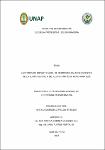Factores de riesgo y nivel de depresión en adolescentes de la junta vecinal 6 de Julio distrito de Punchana 2022
Abstract
The objective of the study is to determine the relationship between risk factors: age, sex, family structure, self-esteem and the level of depression in adolescents from the 6 de Julio Neighborhood Council of the Delicia Manzur human settlement, in the district of Punchana 2022. The study method was quantitative, descriptive, correlational, with a non-experimental and crosssectional design; the study population was made up of 100 adolescents and the size of the study population was 100% of it, that is, 100 adolescents. The technique used was the interview, the instrument a record sheet of risk factors, the Rosenberg self-esteem scale (reliability 0.754) and the Zung depression self-assessment scale (validity 0.78 and reliability 0.93 to 0.97). The most relevant results are: in terms of age, 23% had mild depression, 17% belonged to early adolescence and 6% to late adolescence, finding a significant statistical relationship between both variables (X2=3.890, p=0.049 ; < α=0.05). Regarding sex, 23% had mild depression, 14% belonged to the female sex and 9% to the male; finding that there is no significant statistical relationship between both variables (X2=0.743, p=0.389; > α=0.05). Regarding the family structure, 23% had mild depression, 9% belonged to a nuclear family, 2% to the extended one, 4% to the extended one, 6% single parent and 2% reconstructed; finding that there is no significant statistical relationship between both variables (X2=6.145, p=0.189; α=0.05). Regarding self-esteem, 23% had mild depression, 3% had high self-esteem and 20% low self-esteem, finding that there is a significant statistical relationship between both variables; (X2=13.826, p=0.000; α=0.05). It is concluded that there are risk factors that are related to depression in adolescence such as: age and self-esteem. El estudio tiene como objetivo determinar la relación entre los factores de riesgo: edad, sexo, estructura familiar, autoestima y el nivel de depresión en los adolescentes de la Junta Vecinal 6 de julio del asentamiento humano Delicia Manzur, en el distrito de Punchana 2022. El método de estudio fue cuantitativo, descriptivo, correlacional, con diseño no experimental y transversal; la población de estudio lo conformaron 100 adolescentes y el tamaño de la población de estudio fue el 100% de ésta, es decir 100 adolescentes. La técnica empleada fue la entrevista, el instrumento una ficha de registro de factores de riesgo, escala de autoestima de Rosenberg (confiabilidad 0,754) y escala de autovaloración de depresión de Zung (validez 0,78 y confiabilidad 0,93 a 0,97). Los resultados más relevantes son: en cuanto a edad, el 23 % tuvieron depresión leve, el 17 % pertenecían a la adolescencia temprana y el 6 % a la adolescencia tardía, encontrando relación estadística significativa entre ambas variables (X =3,890, p=0,049; < α=0,05). En cuanto a sexo, el 23 % tuvo depresión leve, el 14 % pertenecían al sexo femenino y 9 % al masculino; encontrando que no existe relación estadística significativa entre ambas variables (X2 =0,743, p=0,389; > α=0,05). En cuanto a la estructura familiar el 23% tuvo depresión leve, el 9 % pertenecían a una familia nuclear, el 2 % a la extendida, el 4 % a la ampliada, el 6 % monoparental y 2 % reconstruida; encontrando que no existe relación estadística significativa entre ambas variables (X2=6,145, p=0,189; α=0,05). En cuanto a autoestima, el 23% tuvo depresión leve, el 3% presentaron autoestima alta y el 20 % autoestima baja, encontrando que existe relación estadística significativa entre ambas variables; (X2=13,826, p=0,000; α=0,05). Se concluye que existen factores de riesgo que se relacionan con la depresión en la adolescencia como: edad y autoestima.
Collections
- Tesis [251]


